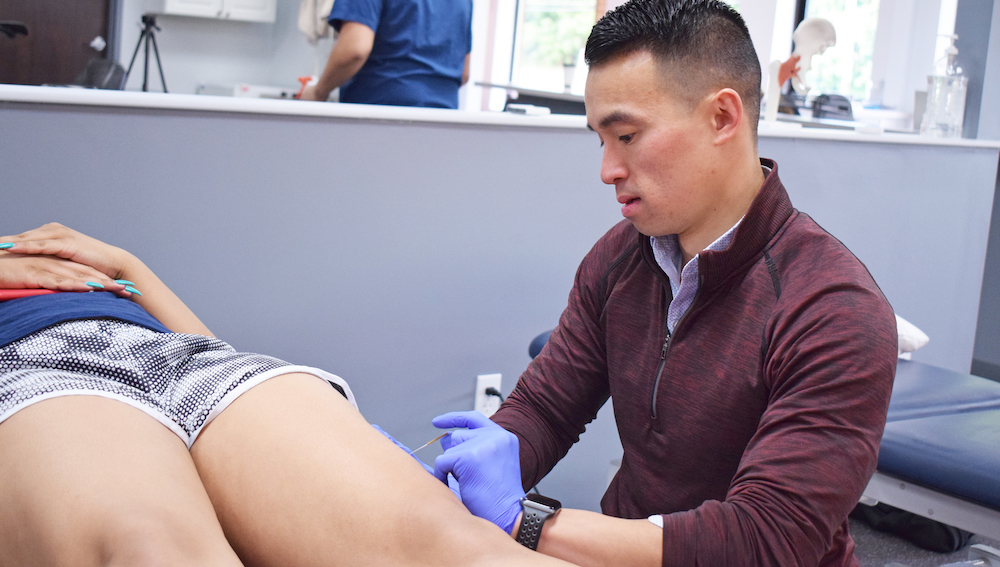Spring is officially here! With warmer weather and longer days usually comes an increase in physical activity, and a sudden increase in physical activity can often cause sore, aching muscles and maybe even injuries like pulls, knots and strains. These issues can linger for weeks, months, or even throughout the entire summer, throwing a wrench into your weekend and vacation activities. But fear not! A number of physical therapists are trained in a technique called Trigger Point Dry Needling (TDN), which is used to relieve muscle pain and injury quickly and effectively.
Why do my muscles hurt?
Before understanding how TDN works, it’s important to understand the causes of your pain.


Delayed onset muscle soreness (DOMS) occurs when you’re working the muscles in a different or more challenging way. Usually lasting between 3 and 5 days, DOMS can make normal daily movement a stiff and painful experience. While the jury is still out on what causes DOMS, the prevailing theory is that it’s caused by “micro-trauma” to the muscles, which happens when you perform exercises using muscles that aren’t used to that type or level of activity.
Even worse than DOMS, inflammation can occur as a result of repetitive muscle use or acute trauma. In response, the body produces scar tissue, which can build up around the muscle. This can limit muscle function and create tightness and pain as your damaged tissue goes into “protective mode” by contracting to stop further damage.
While things like ice and stretching can help to ease and prevent muscle soreness, stiffness and inflammation, Trigger Point Dry Needling can speed up the body’s healing process, allowing you to get back to your daily activities pain-free.
What is Dry Needling?
TDN is a manual technique involving a licensed physical therapist inserting a sterile monofilament needle into the effected muscle. We know – the word “needle” would make you run for the hills (if your legs weren’t already so sore), however you can rest assured that this is not your typical needle used for medical purposes. A monofilament needle is flexible and hair-thin – much smaller than ones used for shots or injections and nothing to be afraid of!


As a result of the needle being inserted into the problem area, the muscles contract and release, and your body will initiate the immune system. This all helps to increase blood flow and promote healing in the area, resolving pain and stiffness, improving muscle function and flexibility, and accelerating the healing process.
A common misconception is that TDN is the same as acupuncture, but there are significant differences between the two. Most importantly, acupuncture is a practice based on traditional Chinese medicine, while dry needling is founded upon the science of western medical research and principles. Another misconception is that dry needling will be painful, but in most cases patients feel little to no pain at all during the needling process, and the typical sensation after the process is of light aching.
Trigger Point Dry Needling is not only an effective treatment for muscle pain – it can be used to treat a wide range of pain and injury, including:
- Joint pain
- Disk problems
- Tendinitis
- Migraine and tension-type headaches
- Jaw and mouth problems (such as temporomandibular joint disorders or TMD)
- Whiplash
- Repetitive motion disorders (like carpal tunnel syndrome)
- Spinal problems
- Pelvic pain
- Night cramps
- Phantom pain
- Arthritis
Get TDN and feel better faster!
Increasing your physical activity is great for your health, and there’s no reason to let muscle pain or injury keep you sidelined for extended periods of time. Trigger Point Dry Needling has proven to be an effective treatment to relieve pain quickly and get you back out there. As a bonus, your physical therapist can assess your injury to let you know if there are ways to prevent it from happening again, including proper form, alignment, muscle balance and exercises tips. It’s a part of our goal to not only treat pain, but to help improve the quality of people’s lives!
If you’re experiencing pain, reach out to one of our clinics today to see how we can help your muscles function better through Trigger Point Dry Needling or a customized Physical Therapy program.
